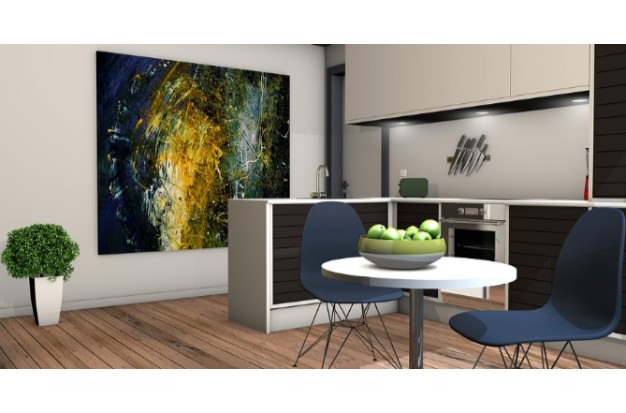
You probably spend more time at work than at home if you’re like most people. You considered purchasing some plants to make your workdays more tolerable.
1. Peace Lily
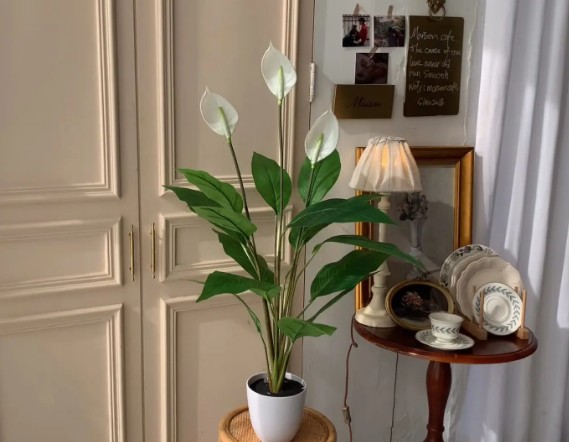
The peace lily, in spite of its name, is primarily a plant. The peace lily, also known as the sathiphylullum, does appear to be sprouting a solitary white flower petal. The plant’s leaf bract is what you’re actually observing. That encircles the yellow portion of what is a flower.
Watch your peace lily grow after you remove it from the source of bright light. Some peace lilies can grow as tall as 24 inches, while others can reach 40 inches.
It’s alright if your office only has fluorescent lighting. The peace lily can grow to its full potential in dimly lit and moderately lit areas.
It is probably too light-exposed if you notice the leaf bract hasn’t formed or your peace lily is beginning to turn brown or even black. Oh, and peace lilies are healthy because they naturally purify the air.
2. Spider Plant
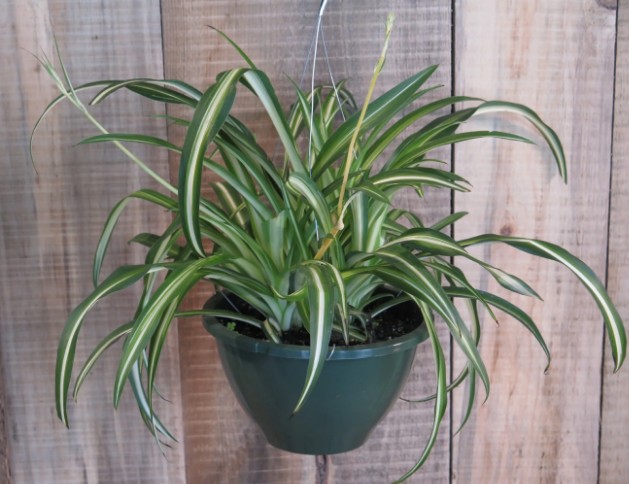
A few more common names are “Hen and Chickens,” “Ribbon plant,” and “Spider Ivy”. Spider Plant thrives in low light, is hardy, and needs only infrequent watering, making it the ideal indoor plant for time-pressed gardeners. These indoor plants can grow quickly in the majority of office buildings and require little maintenance.
Frequently, spider plants flourish and grow well indoors where they can be replanted, and on occasion they will even produce young spider plants.
Spider plants favor soil that drains well. Pick a potting mix with good drainage capabilities. Root rot can also be avoided by reducing standing water!
3. ZZ Plant
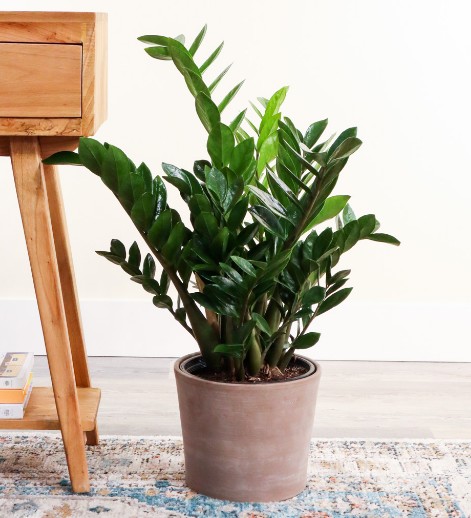
The ZZ plant, also known as zamioculcasi, is the next plant we suggest if you don’t have access to sunlight. There is a lot of foliage on this plant, and the leaves are small and waxy.
As an added bonus, you can’t really mess up taking care of it, so it will make you happier when you arrive at work each day. It’s one of those plants that actually suffers from direct light.
The ZZ plant will curl up and turn yellow if it receives too much light, so you are correct. If you can, keep it away from fluorescent lights. Working spaces with less light are ideal.
4. Snake Plant
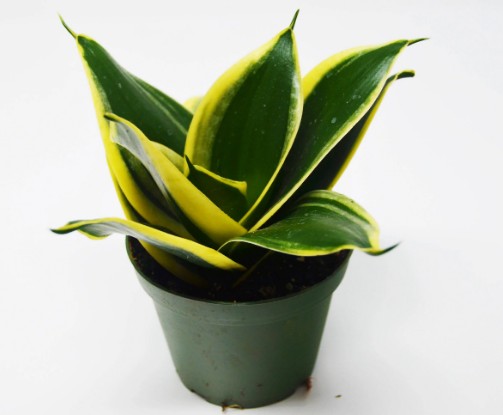
The Sansevieria plant also goes by the name “Snake plant” due to its distinctive leaf pattern and shape. The mother-in-law’s tongue is another name for it. It is an evergreen, adaptable plant. Watering is sufficient for Sansevieria because it doesn’t require additional humidity.
It doesn’t need a lot of water. On cold days, feeding it will only be necessary once a month. If it’s hot, water more frequently, but never let the topsoil dry out. To water the leaves, do so while they are still damp.
Although it can tolerate temperatures as low as 53 degrees Fahrenheit, higher temperatures are preferred by it. Regular plant food and twice-yearly fertilization are required. While uncommon, blooms can appear in the spring. It’s important to remember that sansevieria has a small potential for toxicity.
5. English Ivy
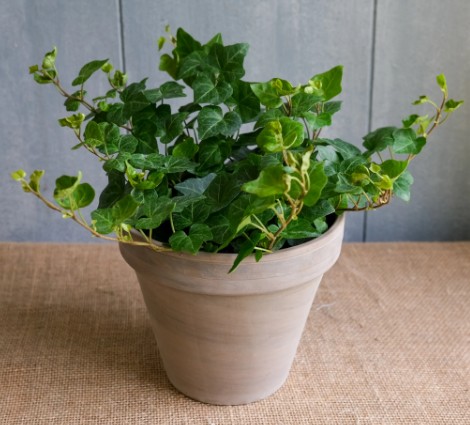
An evergreen perennial, English ivy (Hedera helix). Another name for it is a woodyvine. When spread horizontally, English ivy can serve as a ground cover. Its aerial roots, which enable it to reach heights of 80 feet, also allow it to climb up to that height.
Although the plant will eventually produce tiny, greenish flowers, it is primarily grown for its evergreen foliage. The best time to plant English ivy is in the spring because it is a leafy plant. English ivy is an aggressive, quickly spreading plant that has the potential to become invasive in many locations. Keep an eye on your children and pets because English ivy can be toxic to both people and animals.
6. Bromeliad Guzmanias
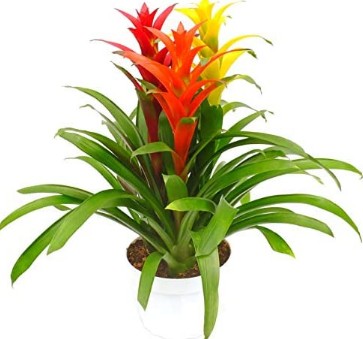
If you want to smell like a Brazilian forest from your office, a bromeliad is the best option. They can withstand extended droughts, but if you water too much, they won’t be able to forgive you. Once the roots start to rot and die, you will notice them.
The top layer of soil needs to dry out before being watered, just like with aloe vera. It is also crucial to have good drainage. Ensure that your pot has adequate drainage holes. Bromeliads also have a “water tank.” It is situated in the middle of the plant and is plain to see. The tank should ideally be filled with rainwater.
7. Philodendron
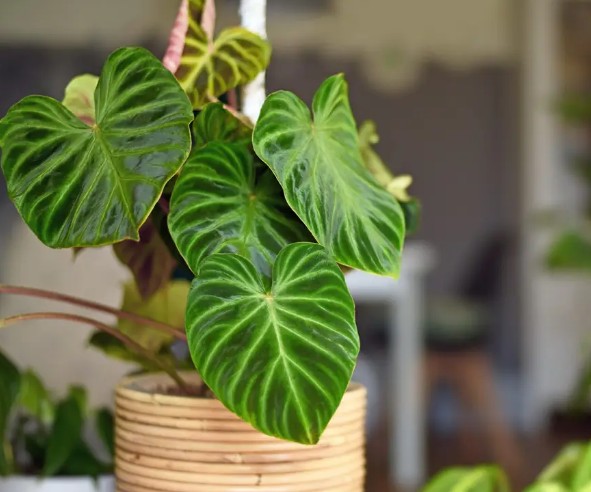
Philodendron is a perennial vine that is simple to grow. Since it’s from Tropical America, you can mimic its natural habitat there. Philodendron plants can purify the air and are advised for use in workplaces. Pruning and shaping are necessary because it grows quickly.
Philodendrons don’t require a lot of water, especially when there isn’t any sunlight. As a result, watering should be done about once per week. While keeping it at 60 degrees Fahrenheit, it can withstand high temperatures.
8. Chinese Evergreen
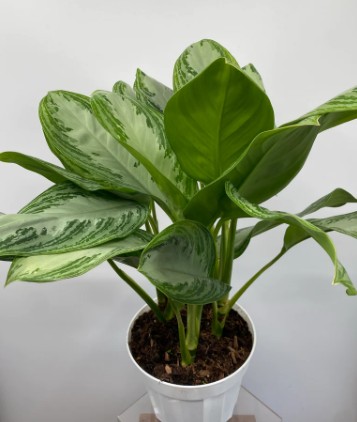
Aglaonemas are among the best indoor low-light plants for rooms without windows. These plants thrive in offices without windows and in low light settings.
These easy-to-care-for office plants, also known as Chinese Evergreens, come in a variety of colors and could add some life to any dark corner of your cramped workspace.
Dark green species require the least amount of direct light, and their colors can also be used to predict how much natural light they need.
Check out our article on Container Gardening For Beginners if you have no experience gardening.
9. Parlor Palm
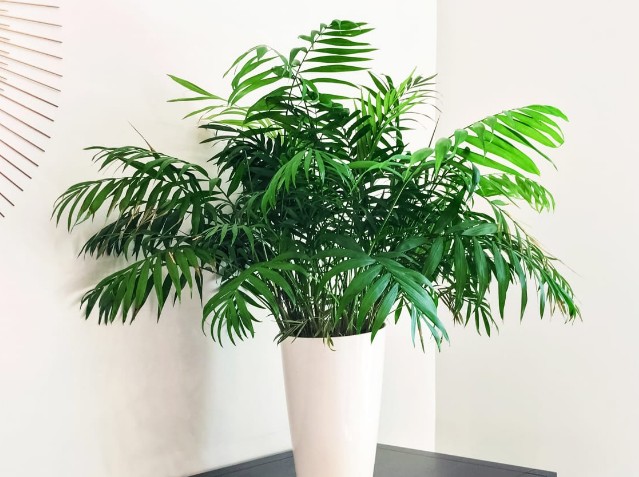
The Parlour Palm is a classy, low-maintenance plant that looks good in any location in the room. As a common indoor plant in Victorian mansions, the Parlour Palm earned its name.
By putting them in floor-standing planters, you can keep these slow-growing palms in an office without windows. Round containers are best for them because they highlight their bushy appearance.
Maintain your Parlour Palm with fluorescent lighting and moderate, infrequent watering; it thrives in low light and dry soil.
10. Cast Iron Plant
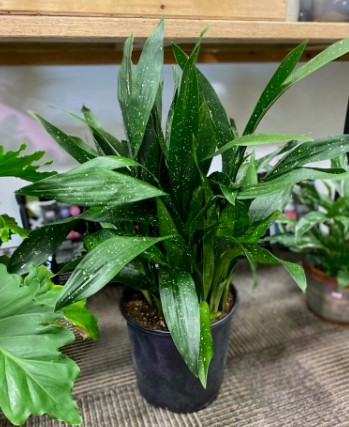
The Aspidistra elatior, or cast iron plant, is very hardy, just like the metal it is named after. Once your cast iron plant sprouts its enormous, curved green leaves, it should be able to withstand almost anything, though you will need some patience to get through the growing phase (since it’s not a particularly fast growing plant).
Without regular cleaning, the leaves may become dusty and dirty, which will make it more difficult for the cast iron plant to absorb nutrients from light. You can maintain this plant’s cleanliness with a soft cloth. It is best to use indirect lighting when possible.
11. Money Tree

In subtropical and tropical regions of the world, it is a very common houseplant, but it is also welcome in your office! Given that it is well known for attracting happiness and wealth, it has a potent spiritual influence.
Plants for money trees require soil that drains well. Sand and perlite should be combined with regular potting soil. Touch the topsoil before watering. In order to prevent cracking, it should be kept dry but not too dry. In the summer, they should be watered once every seven to ten working days, and once every two to three weeks in the winter.
12. Succulents
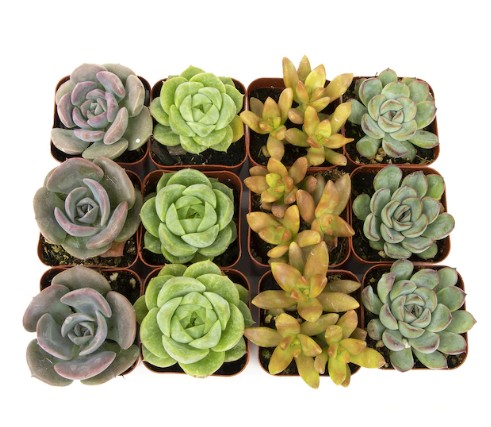
Succulents come to mind when discussing plants that are difficult to kill. They can go for extended periods without water, but be cautious because too much water can be harmful. While artificial light, such as the fluorescent lights in your office, will work just fine, succulents do have specific lighting needs.
13. Peacock Plant
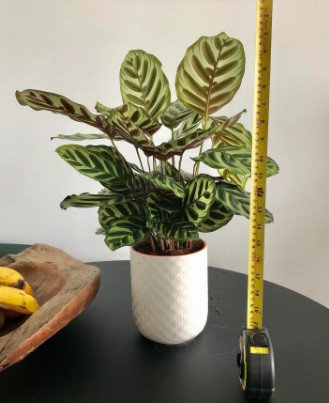
Although growing the peacock plant is difficult, it is manageable. The environment must be humid and moist. Giving your plants frequent misting and watering will allow them to fully express themselves. Additionally, surround your plant with water bowls.
Wet pebbles can be placed in the pot using a tray. When watering or misting, use lukewarm water. Peacock plants can be sensitive to certain chemicals in tap water, such as fluoride and nitrogen. You should use distilled water or rainwater.
During the growing season, a liquid fertilizer can be used. The plant will need to be pruned on occasion. The foliage of peacock plants is exquisite and distinctive, making all the effort worthwhile.
14. Pothos Plant
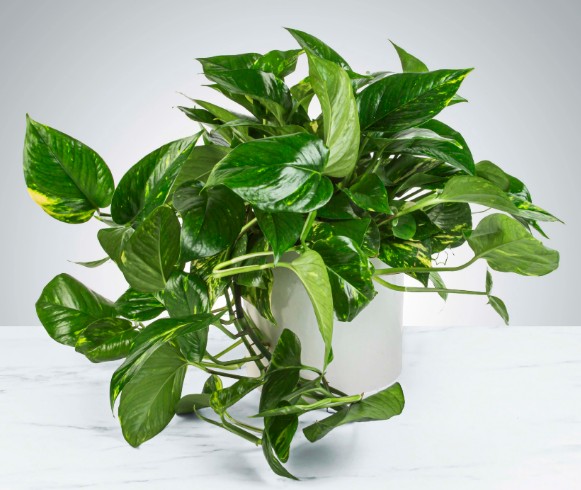
The Epipremnum aureum, also known as the Pothos, is another wonderful plant that will thrive in a room devoid of windows. When you want to have a plant inside but don’t have much natural light, pothos are great. A pothos can brighten the atmosphere in your windowless office if you like having plants that grow long vines.
Although the pothos is perfect for beginners who want a plant in their office despite the absence of windows, you’ll be glad to know that if you ever move to an office with more light, you can grow pothos in low or medium light so moving your pothos to another office with more light will also be fine.
15. Scindapsus Pictus
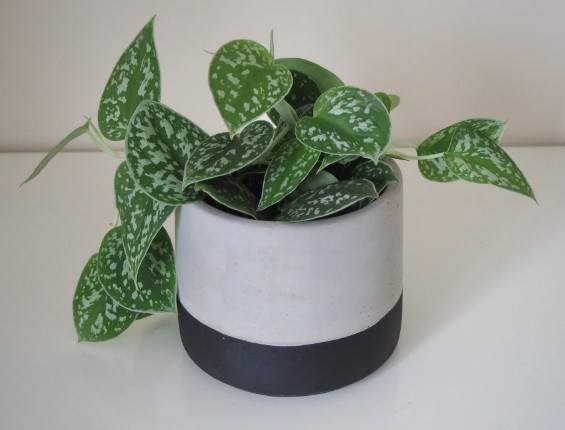
A shelf edge or a wall can be adorned with the Satin Pothos, also known as Scindapsus pictus Argyraeus. Heart-shaped and elegantly satin-textured, the leaves have a distinctive, velvety silver variegation.
The plant is native to Southeast Asia’s rainforests, where it can be seen growing along the ground or clinging to trees.
Allow the soil to feel completely dry before watering again because these plants dislike excessive moisture.
16. Dumb Cane
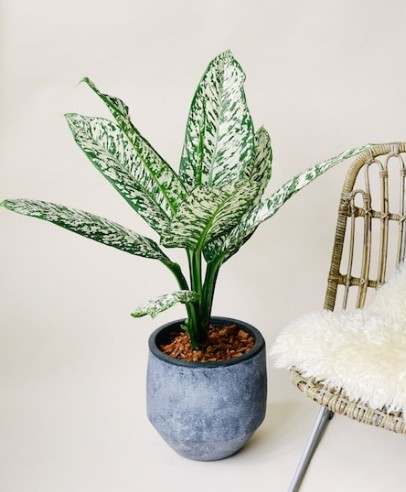
Another great plant that enjoys indirect light is the dumb cane, which can give your windowless offices a glitzy feel. Their enormous, magnificently patterned leaves give indoor spaces a tropical vibe. Even in home offices, dumb cane can be used as partitions.
In spite of their beauty, Dumb Cane plants are poisonous and should not be kept in a home with children or animals.
17. Prayer Plant
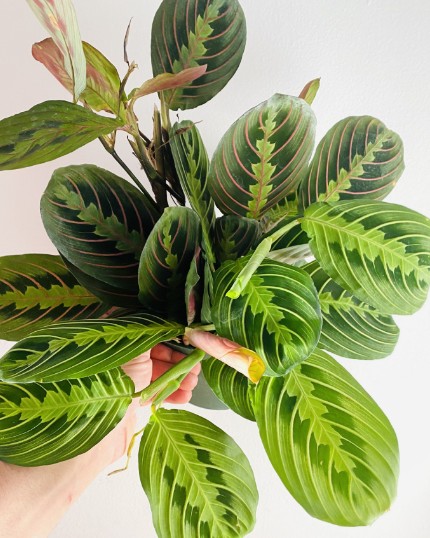
In the family of prayer plants, there are numerous plant species with distinctive colors and patterns. These office plants, also referred to as calatheas, prefer moist conditions and do well in fluorescent and indirect light.
The Red Calatheas is one of the most popular varieties of prayer plants. Their vibrant red veins and emerald leaves give windowless rooms a charming appearance.
If you want something more flamboyant, look for the Calatheas Peacock plant, whose foliage comes in a variety of colors from green to red.
18. Bird’s Nest Fern
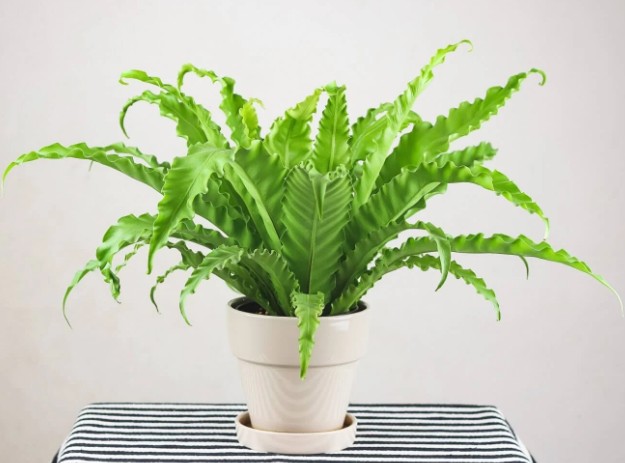
In its natural environment, this leafy plant usually grows on other plants. However, it is best to keep it close to a moist, highly humidified area when cultivating it indoors as a house plant.
Once potted, don’t move or repot the plant unless it has significantly expanded.
erns come in a wide variety of colors and textures. The Bird’s Nest Fern has broad, uncomplicated fronds that resemble banana leaves and are tropical in nature. They emerge from a central rosette with light green, frequently crinkled or waved fronds. The rosette’s common name comes from the fuzzy area where the emerging fronds resemble bird eggs.
19. Cornstalk
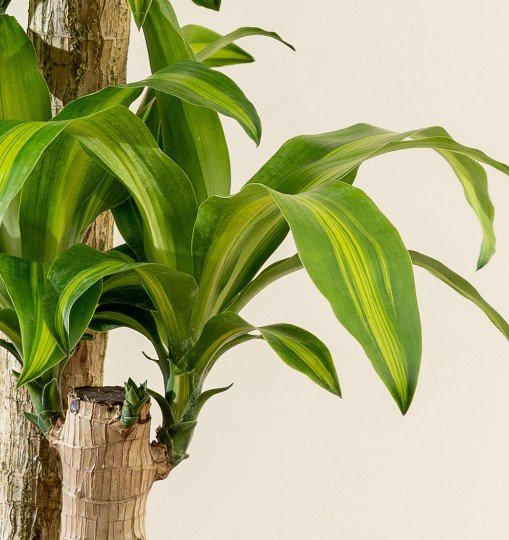
This is one of those types of species that looks the part if you’re a grower looking for a plant for a focal point or a center piece in a room. Once it reaches maturity and reaches a height of over 4 feet, it makes a perfect office or hotel plant and looks professional in spacious living rooms and hallways.
This plant develops one or more canes (stems), and near the top of each cane it produces new stems and a crown of leaves. Indoors, these canes have a maximum height of 6 feet, or they can be cut at the top as soon as they reach the right height.
The most common leaf types on D. fragrans can have a yellow center and an outer edge. fragrans massangeana), or yellow and green striped edges with green in the center (David Fragrans Lindenni). The rosette-like leaves are broad, glossy, and lanceolate.
20. Peperomia
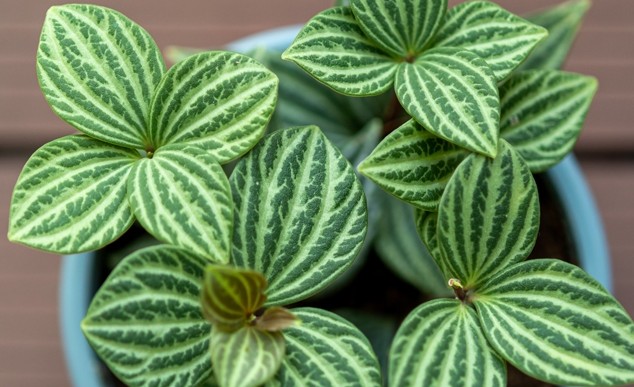
Peperomia plants come in a wide variety and are all attractive to the eye. Peperomias prefer dim light, so an office without windows is the perfect place for them.
Their propensity for delayed growth in low light and shadowed areas can be overcome with fluorescent lighting.
Peperomia’s small, waxy leaves, which can be red, green, or variegated, make them a beautiful addition to any décor.
These cute desk plants can be added to colorful pots to bring life to your office desk.
21. Dragon Tree
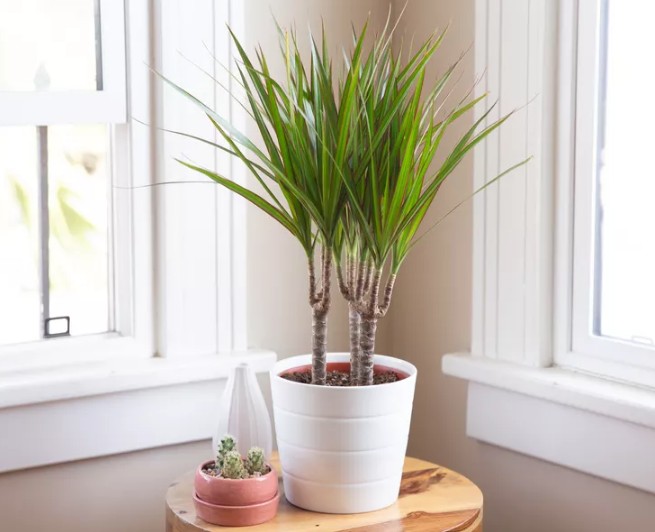
Plants called dragon trees to look like they were plucked right out of a stunning alien landscape and hate direct sunlight. They are a fantastic option for dark workspaces and do well in rooms with filtered and low light.
In addition, the plant still works well if your office is decorated in a sci-fi style. Their slender, spiky leaves look striking in a home office.
22. Aloe Vera
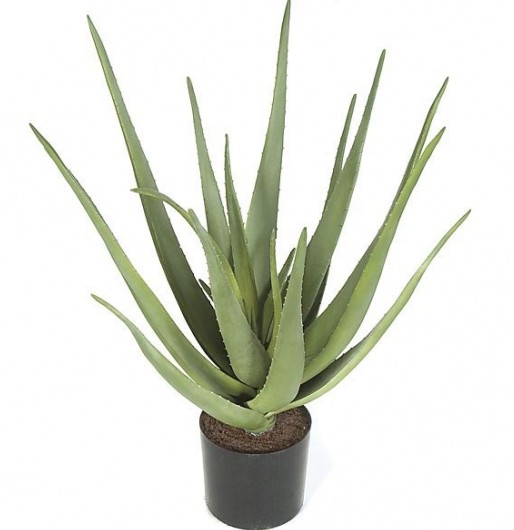
It is among the most cherished indoor plants in the country. It is a great option for offices without windows as well. Sunlight is ideal for aloe vera growth. It doesn’t need much watering because it’s a succulent. Its dense, nourishing leaves serve as water reservoirs.
The biggest threat to succulents is overwatering. Before watering the plant, take care to make sure the soil layer is completely dry. Aloe vera is a perfect plant for an office desk because it is resistant to pests and illnesses.
Do Indoor Plants Attract Pests To The Workplace?
Yes, certain plants will draw bugs and other insects. The fungus gnat is one possible unwelcome guest. These bugs scurry about the office, annoying people and causing distractions. Your workspace may also become infested with mites and mealybugs. Mites could consume your developing plant and cause it to die, especially if you have English ivy. Because of their white color, mealybugs can be seen hopping around on some plants’ large leaves.
If you find a critter infestation, you might want to try some bug-removal products or alert someone in your office to the situation.
Can A Plant Cause Allergies?
Plants can, depending on what you’re growing, cause allergies in some people. It’s possible that your plant is to blame if a worker at your workplace frequently exhibits itchiness, sneezing, coughing, and congestion. Discuss the symptoms with the worker before deciding whether to move or even get rid of the plant.
In addition to allergies, bacteria and mold can grow on plants that have standing water or too much water overall (from overwatering). If you water your plant diligently but not excessively and you clean all the water up when you’re done with it, you can prevent mold. By doing this, you can maintain the overall health of your workplace.
Benefits Of Having Indoor Plants In Windowless Rooms
The same main issues affect most businesses, regardless of size. How can my productivity increase? What can I do to reduce downtime?
It seems that having a house plant in the workplace improves productivity and well-being. Having a lot of indoor plants around the office reduces fatigue and increases productivity, according to numerous studies.
A UK study found that adding plants to the workplace 15% higher productivity. Furthermore, they are essential for enhancing air quality. By absorbing CO2 and exhaling pure oxygen, plants serve as a natural air filter.
Furthermore, noxious substances can be filtered out by indoor plants. A number of air pollutants, such as benzene, trichloroethylene, and formaldehyde, are released into the atmosphere by synthetic office furniture.
According to a NASA study, indoor plants can effectively remove harmful pollutants from offices without windows. As a result, the air was cleaner, there were fewer irritants in the air, and the workers were happier.
Conclusion
The most crucial thing to look for is sturdy, trustworthy, and gorgeous pots if you want a stylish backyard and tidy plant displays that you can be proud of.
Our planters are ideal for planting trees, bushes, and simple flower arrangements both indoors and outdoors because they are made of lightweight yet sturdy fiberglass.
